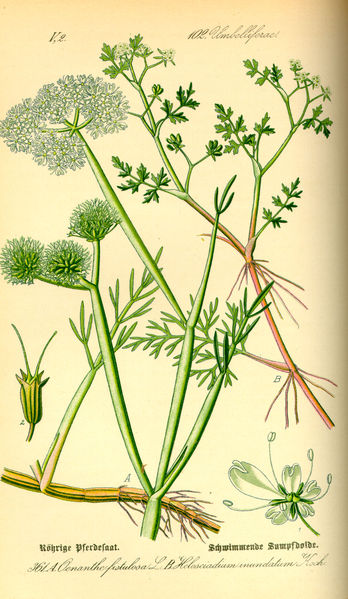Practically every month in my Chemistry World there appears an article where a group of workers has synthesized some natural product with amazing ingenuity. But why, to use a Hogwartsian analogy, does one go to such great effort when the greenhouse is only a walk away from the potions department? So let us join Professor Sprout for a walk around the Hogwarts greenhouses.
Some plant families, such as the Cruciferae and the Labiatae are remarkably free from poisonous plants, whereas others such as the Araceae all seem to come with a toxic hazard warning sign.
The Umbelliferae are generally benign (I think) and give us many useful herbs, but contain a few species which are among the most poisonous, including the hemlock that Socarates drank and the water dropworts Oenanthe  which are among the most deadly plants in Europe, and still give rise to often fatal human poisonings. (Wikimedia picture to right.)
which are among the most deadly plants in Europe, and still give rise to often fatal human poisonings. (Wikimedia picture to right.)
This noxious herb has now found its place in the Potions Department through the researches of, among others, Mauro Ballero, Professor of Pharmaceutical Botany, School of Pharmacy, University of Cagliari (in the south of Sardinia). They haven’t got around to synthesizing the product yet, but they have isolated and characterized the active principle.
But who would use such a plant? The villains of the piece appear to have been the Punics, among whom the most famous is Hannibal who came so near to destroying Rome (talk about a "Clash of Civilizations"!). But what is the evidence for this? According to the Italian news release
Greek poet Homer first used the word, an adaptation of the ancient word for Sardininan, to describe a defiant smile or laugh in the face of death.
He was believed to have coined it because of the belief that the Punic people who settled Sardinia gave condemned men a potion that made them smile before dying. The Punics were convinced that death was the start of new life, to be greeted with a smile.
Describing the background to their research, the team write [1]:
According to ancient historians, elderly people unable to support themselves were intoxicated with the herb and then killed by being dropped from a high rock or by being beaten to death.The facial muscular contraction induced by the sardonic herb mimicked a smile, and the expression risus sardonicus (sardonic smile) to indicate a sinister smile is well documented in the Latin and Greek literature and in most modern European languages.
So that Sardonicism has come to mean the expression of derision, cynicism, or sceptical humour variously through comment, gesture, or writing.
The compounds isolated by the team are polyacetylenes, and one marvels at the chemical arms race that the plant must have had with its enemies to produce such a bizarre type of molecule in a living organism.
.gif)
(picture from the abstract)
And is there anything in it for humans? This class of compounds has a unique capacity of dramatically perturbing calcium and sodium ionic currents in excitable membranes, and specifically interacting with ligand-gated ion channels like the GABAA receptor. Risus sardonicus is most often observed as a sign of tetanus, and may also result from poisoning with strychnine. "The good news is that the molecule in this plant may be retooled by pharmaceutical companies to have the opposite effect," says Dr Ballero.
[1] Polyacetylenes from Sardinian Oenanthe fistulosa: A Molecular Clue to risus sardonicus
Giovanni Appendino, Federica Pollastro, Luisella Verotta, Mauro Ballero, Adriana Romano, Paulina Wyrembek, Katarzyna Szczuraszek, Jerzy W. Mozrzymas and Orazio Taglialatela-Scafati
Journal of Natural Products, Article ASAP: DOI: 10.1021/np8007717 http://pubs.acs.org/doi/abs/10.1021/np8007717




Comments